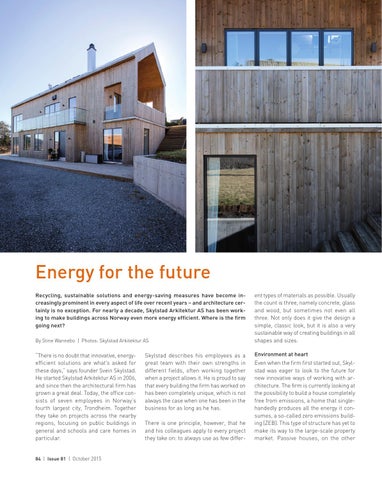2_3_ScanMagazine_Issue_81_Oct-Nov_2015_Scan Magazine 1 15/10/2015 21:36 Page 84
Energy for the future Recycling, sustainable solutions and energy-saving measures have become increasingly prominent in every aspect of life over recent years – and architecture certainly is no exception. For nearly a decade, Skylstad Arkitektur AS has been working to make buildings across Norway even more energy efficient. Where is the firm going next? By Stine Wannebo | Photos: Skylstad Arkitektur AS
“There is no doubt that innovative, energyefficient solutions are what’s asked for these days,” says founder Svein Skylstad. He started Skylstad Arkitektur AS in 2006, and since then the architectural firm has grown a great deal. Today, the office consists of seven employees in Norway’s fourth largest city, Trondheim. Together they take on projects across the nearby regions, focusing on public buildings in general and schools and care homes in particular.
84 | Issue 81 | October 2015
Skylstad describes his employees as a great team with their own strengths in different fields, often working together when a project allows it. He is proud to say that every building the firm has worked on has been completely unique, which is not always the case when one has been in the business for as long as he has. There is one principle, however, that he and his colleagues apply to every project they take on: to always use as few differ-
ent types of materials as possible. Usually the count is three, namely concrete, glass and wood, but sometimes not even all three. Not only does it give the design a simple, classic look, but it is also a very sustainable way of creating buildings in all shapes and sizes. Environment at heart Even when the firm first started out, Skylstad was eager to look to the future for new innovative ways of working with architecture. The firm is currently looking at the possibility to build a house completely free from emissions, a home that singlehandedly produces all the energy it consumes, a so-called zero emissions building (ZEB). This type of structure has yet to make its way to the large-scale property market. Passive houses, on the other
